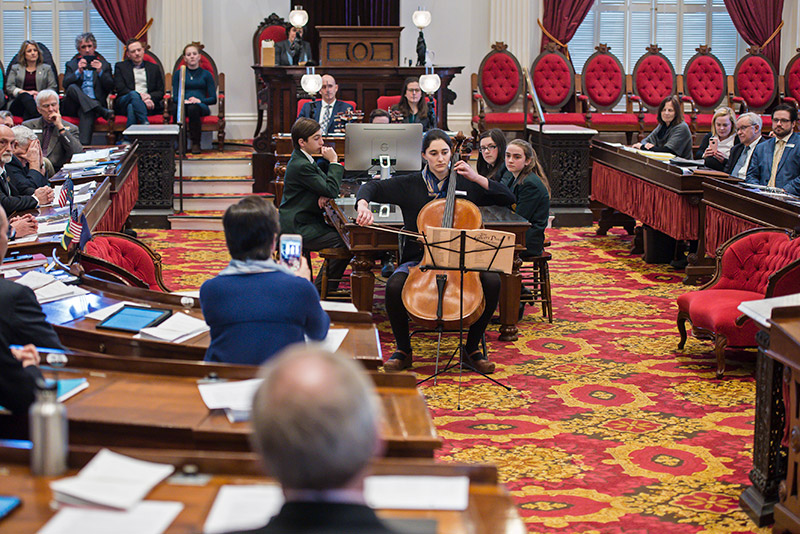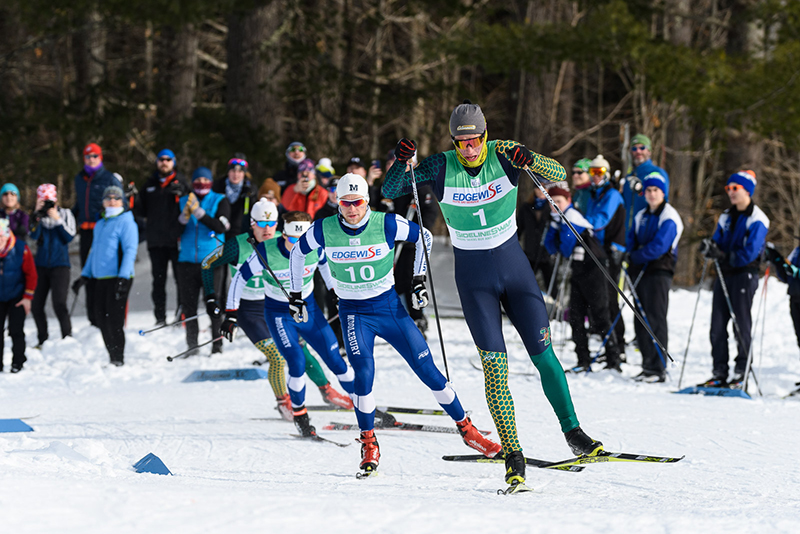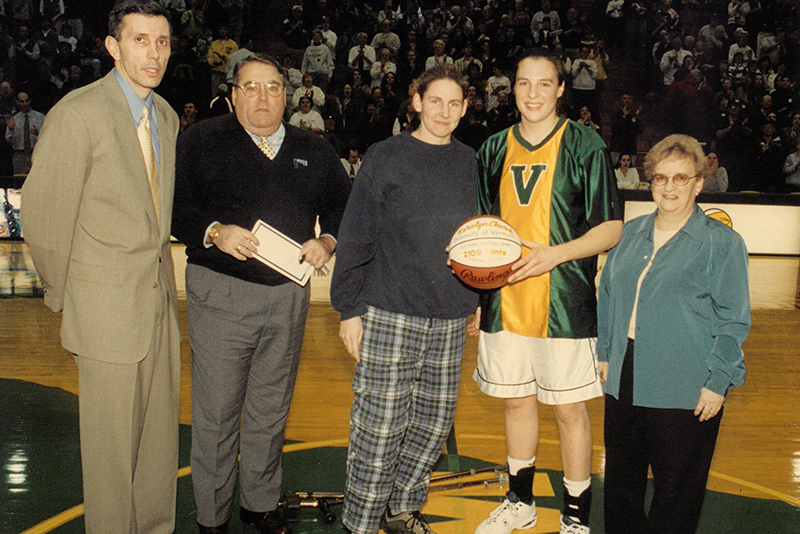As March Madness approaches, we reached out to a circle of Vermont basketball alumni to catch up on where life has taken them and reflect on their days in green-and-gold.
Taylor Coppenrath ’05
A home-state hero from West Barnet, Coppenrath went on to a successful international career in basketball across a decade playing in Europe, primarily in Spain. After retiring as a player, he returned to Vermont, where he teaches ninth grade math and coaches girls’ varsity basketball at Missisquoi Valley Union High School. “Math is always a challenging subject,” Coppenrath says. “Then to add the fourteen-to-fifteen year-old mindset and hormones, it can be quite interesting and challenging at times.” But it’s a worthy challenge. Coppenrath adds that it’s his hope to “influence students to be good people, succeed in life, and believe in themselves.”
Catamount Highlight: The NCAA first round shocker over Syracuse, of course. Teammate Germain Mopa Njila’s very big game (24 points) and T.J. Sorrentine’s very big shot (that three “from the parking lot”) stand out in Coppenrath’s memory.
A Student-Athlete’s Lessons: Coppenrath rattles off a long list of what he learned as a varsity athlete—family, hard work, communication, pride, humility, and a growth mindset, to name a few.
Dr. Karalyn Church ’00 MD’06
One of Vermont’s all-time basketball greats, Church was a two-time America East Player of the Year, two-time Catamount MVP, and the first UVM women’s basketball player to earn an invitation to the WNBA Pre-Draft Camp. The native of Canada now lives in London, Ontario, where she is an emergency physician, assistant professor at Western University, and also travels to rural and under-served hospitals in the province. “The challenges are the same things that make my job fulfilling,” Church says. “No two days are ever the same. I care for people ages 0 to over 100 and almost all are in a state of fear, pain, anxiety or concern when they arrive. Creating a bond and providing the right care for this wide range of patients is always a different dance day after day.”
Catamount Highlight: Win over Maine in the 2000 America East Championship game. “I remember the feeling when I realized that all systems were go, every single player on the team was in full form, and I knew we were going to crush them. Patrick Gym was packed, my teammates were on fire, and I felt like I had the front row seat on a fully loaded locomotive.”
A Student-Athlete’s Lessons: “Blood, sweat and tears is not just an expression,” Church says. “You learn so much about yourself and about your teammates when you commit to a common goal. It is the same in sport as it is in life.”

Maurice Joseph ’09
A two-time captain for the Cats, Joseph’s on-court leadership skills now play out from the bench, as head coach for George Washington University. He’s the youngest coach in a Top 10 RPI conference, now in his third season in the top job with the Atlantic 10’s Colonials. “Obviously, I’m very passionate about the game of basketball,” Joseph says. “But I believe that as a coach I’m also an educator, and I can teach these guys life lessons through the game of basketball. I have an impact on what type of employee or employer they are going to become one day, what kind of husband, what kind of father… That’s not a job that I take for granted.” Fellow UVM basketball alumnus Chris Holm ’07 is one of Joseph’s assistant coaches.
Catamount Highlight: 2010 America East Championship victory over Boston University at Patrick Gym. Joseph says, “My teammate Evan Fjeld had just lost his mother. So, it was tough on our team; obviously, very tough on Evan. So to be able to win that championship in Patrick Gym and win it for him, that was one of the most special things that I’ve ever experienced in my life.” Joseph adds that the day he received his UVM bachelor’s in psychology, the first in his family to earn a college degree, was also a lifetime moment.
A Student-Athlete’s Lessons: The importance of relationships, Joseph says. “Whether you’re a teammate or a coach, you’re striving for something together, sacrificing your own needs for the greater good of the group.”

May Kotsopoulos ’10
A team captain for two seasons and MVP for the Catamounts in 2009, Kotsopoulos helped lead Vermont to post-season appearances in the NCAA Tournament and WNIT. Also a dean’s list student all four years, she says the stature of the business school was among UVM’s attractions when she made her college choice. She now lives and works in Toronto as a senior account executive for Salesforce, a cloud-based software company that specializes in customer relationship management tools.
Catamount Highlight: Victory over seventh-seeded Wisconsin in the first round of the 2010 NCAA Women’s Basketball Tournament, the Vermont program’s first win of all time in the tourney. “Growing up in Canada, I used to watch March Madness but never imagined being able to actually be involved, let alone win a game,” she says.
A Student-Athlete’s Lessons: Kotsopolous says that her professional style grows from what she learned as a student-athlete — discipline, coachability, an even-keel perspective. She recalls how, after a strong start to her first Vermont season, one poor performance in a December game shook her confidence. On her sister’s advice, she began working with sports psychologist Sheila Stawinski. “Over the next four years, I worked on tactics and tools to handle stress and pressure, perspective on wins and losses, and how to manage both personal and athletic tough times,” Kotsopoulos says.

Aaron Yantzi Dickie ’04
Dickie (Yantzi during her playing days) was a three-time America East All-Conference player and one of the top scorers in school history. A psychology major at UVM, she later earned her teaching certification at St. Michael’s College and has taught third grade at Grand Isle Elementary School for the past six years. Building relationships, helping children grow, she rates teaching as one of the best jobs in the world. “There is a lot of new content that the kids are expected to learn each year, and I am always amazed and so proud of what they are able to accomplish,” she says. “But they are still only eight- and nine-year-olds who like to have fun. It’s that youthful energy that I try to use to tap into their interests whenever possible.”
Catamount Highlight: Sophomore season, a run to the quarterfinals of the WNIT that included a pair of home wins in front of the Vermont faithful in Patrick Gym.
A Student-Athlete’s Lessons: Teamwork and time management. “My ‘teammates’ no longer wear jerseys, but I still deal with that same dynamic when working with those around me. The better we can work together, the more successful our students will be.” Dickie adds that balancing academics and athletics provided a four-year course in perseverance. “There were many times playing basketball when I was tired, both mentally and physically, but you have to tell yourself to push through it and that same theory applies to many aspects of life.”

Luke Apfeld ’13
A power forward for the Catamounts, Apfeld was a two-time captain who helped lead the team to regular season and conference tournament championships during his years in a Vermont uniform. A double-major in English and sociology, he was a member of UVM’s Honors College. Law school at Cal-Berkeley followed UVM, and Apfeld is now a lawyer living in Brooklyn and working for Judge Andrew L. Carter, Jr., a U.S. District Judge in the Southern District of New York. He says that the work presents the challenge, and fulfillment, of navigating the vastness of the legal field “to wrestle with new and foreign concepts on a daily basis.”
Catamount Highlight: America East Tournament Championship game victory on Stony Brook’s home court. “The environment was electric and deafening — the culmination of a difficult season and journey as a team.”
A Student-Athlete’s Lessons: Apfeld mentions the abilities to push past limits, work as a team, and adds the valuable life lesson of dealing with defeat. “We are all going to lose at times in our lives, and that loss may manifest itself in a number of ways. Being a collegiate athlete teaches you that a loss isn’t the end; it allows you to refocus and channel your energy to improve and continue on having learned from the past,” he says.

Sandro Carissimo ’14
A standout guard for the Catamounts, Carissimo (left, with then-roommate Luke Apfeld) was a leader for Vermont teams that earned conference championships and trips to the post-season in both the NCAA and NIT tournaments. A graduate of the Grossman School of Business, focused on finance and accounting, Carissimo lives in New York City and works for Brigade Capital, a multi-strategy investment management firm. You sense his hoops background in his response to what is fulfilling about the work: “I enjoy the competition aspect, working with the team at Brigade to try and see things in businesses that the broader market may be missing.” (Fun fact: in 2015, Business Insider included Carissimo, who played professionally in Spain after his UVM career, on their lineup of “The 32 Best Basketball Players on Wall Street.”)
Catamount Highlight: Playing in the NCAA Tournament in 2012. The Cats won a First Four round match-up against Lamar, then took on #1 seeded North Carolina. Playing in Greensboro, N.C., Vermont fell 77-58.
A Student-Athlete’s Lessons: Carissimo shares fundamental court wisdom that seems especially apt for the investment world: “Never let yourself get too high or too low in any situation, so you are able to make thought-out decisions based on work you have done rather than making emotional reactions.”

Lauren Buschmann ’13
One of a number of talented Canadian women’s basketball players who took their talents to Burlington for their college careers, Buschmann developed into a top post player in America East. These days, she’s back home north of the border, living and working in Toronto, where she’s a sports scientist, focused on the women’s national basketball team, with the Canadian Sport Institute. Buschmann, who majored in exercise and movement science, says the rapid evolution of her field requires constant learning. “In order to gain a competitive advantage over the other countries, it is imperative that I know the latest trends and research in order to best prepare our athletes. When competing against the top athletes in the world, every advantage is crucial to our team’s success.”
Catamount Highlight: The 2010 post-season, when Buschmann and her teammates made a run through the America East Championship Tournament, then pulled off a first-round NCAA Tournament upset win over Wisconsin.
A Student-Athlete’s Lesson: Time management and finding life balance are core challenges for a college varsity athlete, Buschmann says. Wisdom gained from that experience informs training programs she designs for athletes today, with a mind to balancing hard work and recovery.

Jen MacAulay ’02
As a player, MacAulay was one of Vermont’s career leaders in three-pointers and assists, helping lead the Catamounts to two America East regular season championships and post-season appearances in the NCAA Tournament and WNIT. Today, she is an assistant basketball coach at Smith College. At Smith, and during six years as an assistant at UMass-Amherst, recruiting has been a key focus for MacAulay. “I feel very fortunate to have developed so many amazing relationships with student athletes. These relationships are formed in the recruiting process, grow over their four years as a student athlete and continue after they graduate.”
Catamount Highlight: Second round WNIT win over St. Joe’s, MacAulay’s final game in Patrick Gym. “I got to experience it with teammates who are still some of my best friends today and in front of the most amazing fans in women’s college basketball. Thinking back to playing in front of a sold-out crowd at Patrick Gym still brings me goosebumps. I have coached and played in a lot of other gyms across the country, but there is something so special about Patrick.”
A Student Athlete’s Lessons: A business administration major at UVM, MacAulay boils it down to discipline, time management, and relationship skills. “Being a student athlete at the college level forces you to work with a lot of different types of people so closely and be able to navigate those relationships, some more easily than others,” she says.
Source: UVM News















